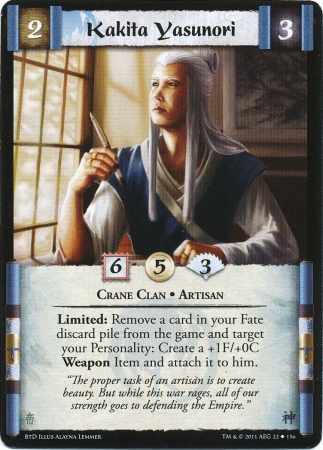

|
|
|
|
|
|
|
|
|
|
|
|
Calligraphy (2, 18): The written language of the Oriental
Adventures world is much different from that
commonly used in other AD&D settings.
Other lands normally make use of alphabets to compose words and
words to compose sentences. However, here the written language is
composed of pictographs (or logograms).
Each character (as a single written pictograph is commonly called)
represents a single word or part of a word.
Originally, the character was like a small painting of the thing
it represented, but time has simplified and
stylized these characters so that they have only a slight resemblance
to the thing anymore. Instead they have
meanings that can be added to or changed when used with other characters.
Each word has a different character
or combination of characters, and thousands of different characters
are needed to write books. Great precision is
needed to write clearly and correctly.
Thus a character's style and artistic ability with the ink-brush
is an important measure of his social worth
in the Oriental Adventures world. The first
impression a stranger forms of a character may well be based on
how graceful and beautiful his calligraphy style is. Indeed, how
well one writes can often be more important
than what the writing actually says. Therefore, calligraphy is a
vital skill for those aspiring to high position in
the Oriental Adventures lands:
The calligraphy proficiency has many uses. It is needed to inscribe
magical scrolls, prepare reports to
one's lord, impress officials, and curry favor from powerful NPCs.
It shows the rank of the writer, and good
writing can be used to add prestige to those of lower birth. A poetry
contest at a court can also be a contest in
calligraphy. A brilliant poem written in a crude and unformed hand
can be less appealing than a good poem
with fine calligraphy. Every time a character writes an important
document, a die roll must be made to find the
quality of the character's calligraphy. The DM can modify the reaction
of any NPC to the message based on the
quality of the calligraphy. Good calligraphy gives a more favorable
reaction; bad calligraphy has the opposite
effect.
Calligraphy requires the use of a writing brush, an inkwell, and
an inking stone. These are normally
carried as a set, but characters can improvise these items when
they must.
* Monks and shukenja receive calligraphy at the cost of only 1 proficiency slot. <>
Q: Several character
classes must
have the calligraphy
proficiency.
A: The class descriptions
seem to indicate
that calligraphy costs
one slot,
but table 61 says it
costs two slots.
Calligraphy requires
two slots.
(151.8)